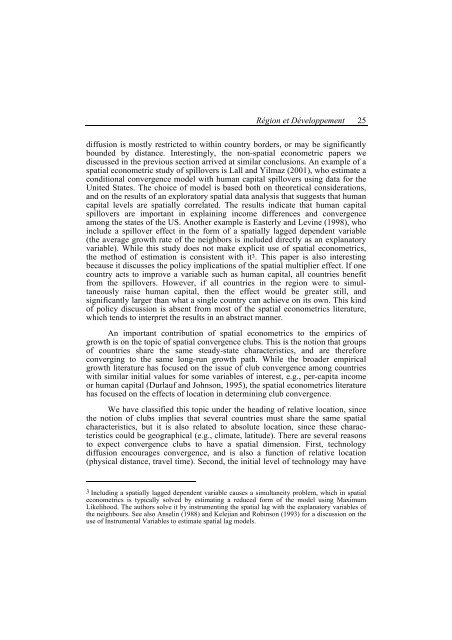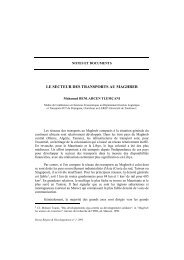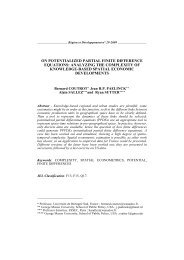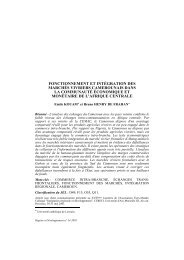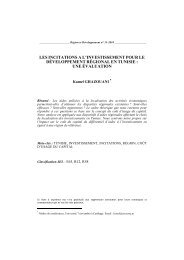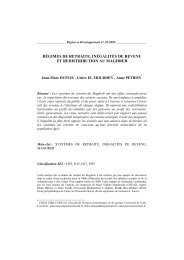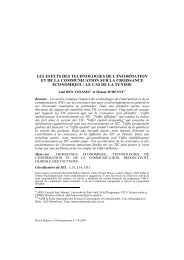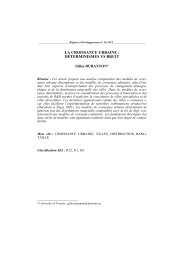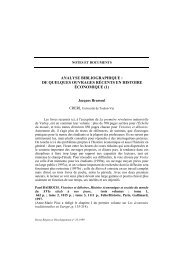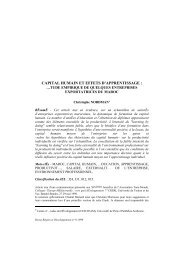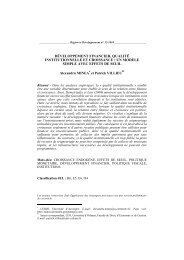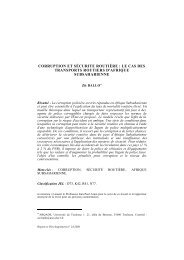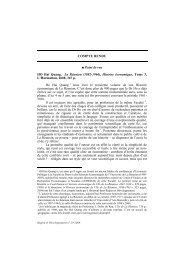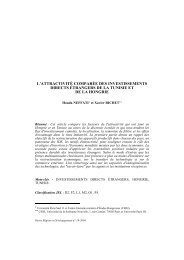space and growth: a survey of empirical evidence ... - ResearchGate
space and growth: a survey of empirical evidence ... - ResearchGate
space and growth: a survey of empirical evidence ... - ResearchGate
Create successful ePaper yourself
Turn your PDF publications into a flip-book with our unique Google optimized e-Paper software.
Région et Développement 25diffusion is mostly restricted to within country borders, or may be significantlybounded by distance. Interestingly, the non-spatial econometric papers wediscussed in the previous section arrived at similar conclusions. An example <strong>of</strong> aspatial econometric study <strong>of</strong> spillovers is Lall <strong>and</strong> Yilmaz (2001), who estimate aconditional convergence model with human capital spillovers using data for theUnited States. The choice <strong>of</strong> model is based both on theoretical considerations,<strong>and</strong> on the results <strong>of</strong> an exploratory spatial data analysis that suggests that humancapital levels are spatially correlated. The results indicate that human capitalspillovers are important in explaining income differences <strong>and</strong> convergenceamong the states <strong>of</strong> the US. Another example is Easterly <strong>and</strong> Levine (1998), whoinclude a spillover effect in the form <strong>of</strong> a spatially lagged dependent variable(the average <strong>growth</strong> rate <strong>of</strong> the neighbors is included directly as an explanatoryvariable). While this study does not make explicit use <strong>of</strong> spatial econometrics,the method <strong>of</strong> estimation is consistent with it3. This paper is also interestingbecause it discusses the policy implications <strong>of</strong> the spatial multiplier effect. If onecountry acts to improve a variable such as human capital, all countries benefitfrom the spillovers. However, if all countries in the region were to simultaneouslyraise human capital, then the effect would be greater still, <strong>and</strong>significantly larger than what a single country can achieve on its own. This kind<strong>of</strong> policy discussion is absent from most <strong>of</strong> the spatial econometrics literature,which tends to interpret the results in an abstract manner.An important contribution <strong>of</strong> spatial econometrics to the empirics <strong>of</strong><strong>growth</strong> is on the topic <strong>of</strong> spatial convergence clubs. This is the notion that groups<strong>of</strong> countries share the same steady-state characteristics, <strong>and</strong> are thereforeconverging to the same long-run <strong>growth</strong> path. While the broader <strong>empirical</strong><strong>growth</strong> literature has focused on the issue <strong>of</strong> club convergence among countrieswith similar initial values for some variables <strong>of</strong> interest, e.g., per-capita incomeor human capital (Durlauf <strong>and</strong> Johnson, 1995), the spatial econometrics literaturehas focused on the effects <strong>of</strong> location in determining club convergence.We have classified this topic under the heading <strong>of</strong> relative location, sincethe notion <strong>of</strong> clubs implies that several countries must share the same spatialcharacteristics, but it is also related to absolute location, since these characteristicscould be geographical (e.g., climate, latitude). There are several reasonsto expect convergence clubs to have a spatial dimension. First, technologydiffusion encourages convergence, <strong>and</strong> is also a function <strong>of</strong> relative location(physical distance, travel time). Second, the initial level <strong>of</strong> technology may have3 Including a spatially lagged dependent variable causes a simultaneity problem, which in spatialeconometrics is typically solved by estimating a reduced form <strong>of</strong> the model using MaximumLikelihood. The authors solve it by instrumenting the spatial lag with the explanatory variables <strong>of</strong>the neighbours. See also Anselin (1988) <strong>and</strong> Kelejian <strong>and</strong> Robinson (1993) for a discussion on theuse <strong>of</strong> Instrumental Variables to estimate spatial lag models.


